@Sabz5150,
[SIZE="3"]The Quran on Human Embryonic Development: [/SIZE]
(The following illustrations are borrowed from 'A Brief Illustrated Guide To Understanding Islam')
In the Holy Quran,
Allah [SIZE="3"]"We (Allah) created man (Adam) from an extract of clay. Then We made him (the offspring of Adam) as a drop in a place of settlement, firmly fixed. Then We made the drop into an alaqah (leech, suspended thing, and blood clot), then We made the alaqah into a mudghah (chewed substance) then We made the mudgah into a little lump of flesh, then We made out of that little lump of flesh bones, then We clothed the bones with flesh, and then We brought it forth as another creation...." 1
[The Noble Quran, 23:12-14][/SIZE]
Literally, the Arabic word alaqah has three meanings: (1) leech, (2) suspended thing, and (3) blood clot.
In comparing a leech to an embryo in the alaqah stage, we find similarity between the two2 as we can see in figure 1. Also, the embryo at this stage obtains nourishment from the blood of the mother, similar to the leech, which feeds on the blood of others.3
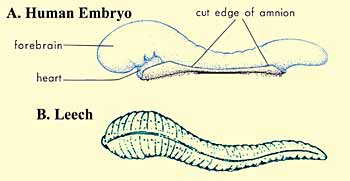 Figure 1
Figure 1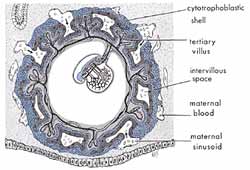 Figure 2
Figure 2: We can see in this diagram the suspension of an embryo during the alaqah stage in the womb (uterus) of the mother. (The Developing Human, Moore and Persaud, 5th ed., p. 66.)
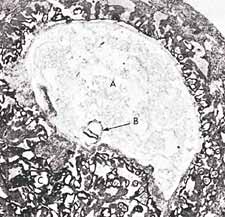 Figure 3
Figure 3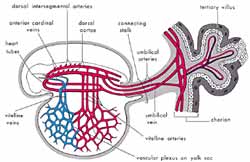 Figure 4
Figure 4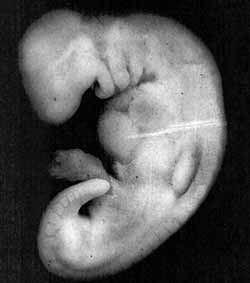 Figure 5
Figure 5: Photograph of an embryo at the mudghah stage (28 days old). The embryo at this stage acquires the appearance of a chewed substance, because the somites at the back of the embryo somewhat resemble teeth marks in a chewed substance. The actual size of the embryo is 4 mm. (The Developing Human, Moore and Persaud, 5th ed., p. 82, from Professor Hideo Nishimura, Kyoto University, Kyoto, Japan.)
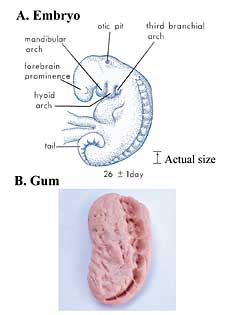 Figure 6
Figure 6: When comparing the appearance of an embryo at the mudghah stage with a piece of gum that has been chewed, we find similarity between the two.
A) Drawing of an embryo at the mudghah stage. We can see here the somites at the back of the embryo that look like teeth marks. (The Developing Human, Moore and Persaud, 5th ed., p. 79.)
B) Photograph of a piece of gum that has been chewed.
How could Prophet Muhammad (peace be upon him) have possibly known all this 1400 years ago, when scientists have only recently discovered this using advanced equipment and powerful microscopes which did not exist at that time? Hamm and Leeuwenhoek were the first scientists to observe human sperm cells (spermatozoa) using an improved microscope in 1677 (more than 1000 years after prophet Muhammad (peace be upon him) ). They mistakenly thought that the sperm cell contained a miniature preformed human being that grew when it was deposited in the female genital tract.7
Professor Emeritus Keith L. Moore8 http://www.islam-guide.com/video/moore-1.ramhttp://www.islam-guide.com/video/moore-2.ram ).
Footnotes:
[SIZE="1"](1) Please note that what is between these special brackets ... in is only a translation of the meaning of the Quran. It is not the Quran itself, which is in Arabic.
(2) The Developing Human, Moore and Persaud, 5th ed., p. 8.
(3) Human Development as Described in the Quran and Sunnah, Moore and others, p. 36.
(4) Human Development as Described in the Quran and Sunnah, Moore and others, pp. 37-38.
(5) The Developing Human, Moore and Persaud, 5th ed., p. 65.
(6) The Developing Human, Moore and Persaud, 5th ed., p. 8.
(7) The Developing Human, Moore and Persaud, 5th ed., p. 9.
(8) Note: The occupations of all the scientists mentioned in this web site were last updated in 1997.
(9) The reference for this saying is This is the Truth (videotape). For a copy of this videotape, please visit this page.
(10) This is the Truth (videotape).
(11) This is the Truth (videotape). For a copy, see footnote no. 9. [/SIZE]